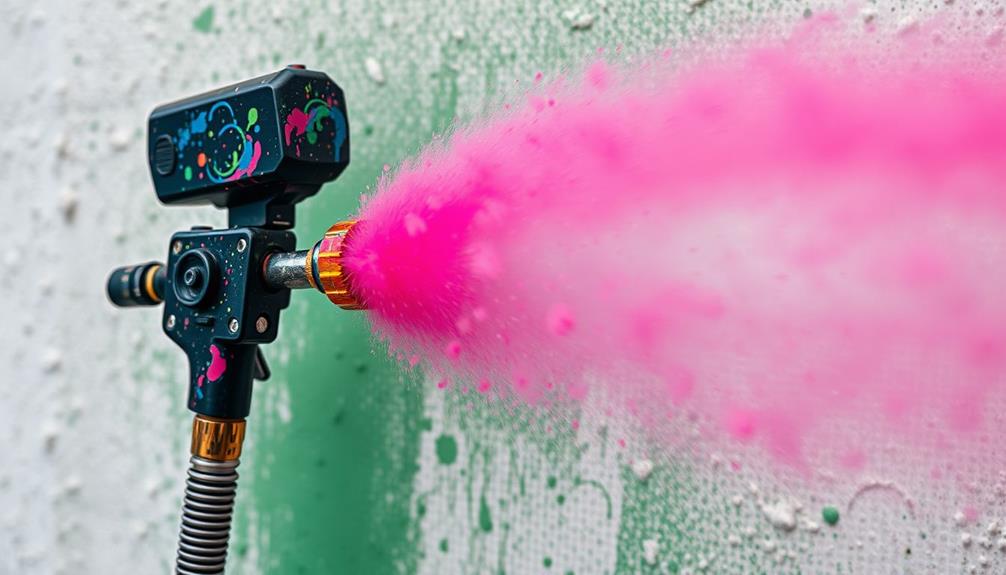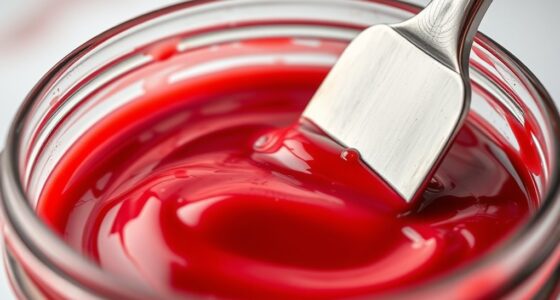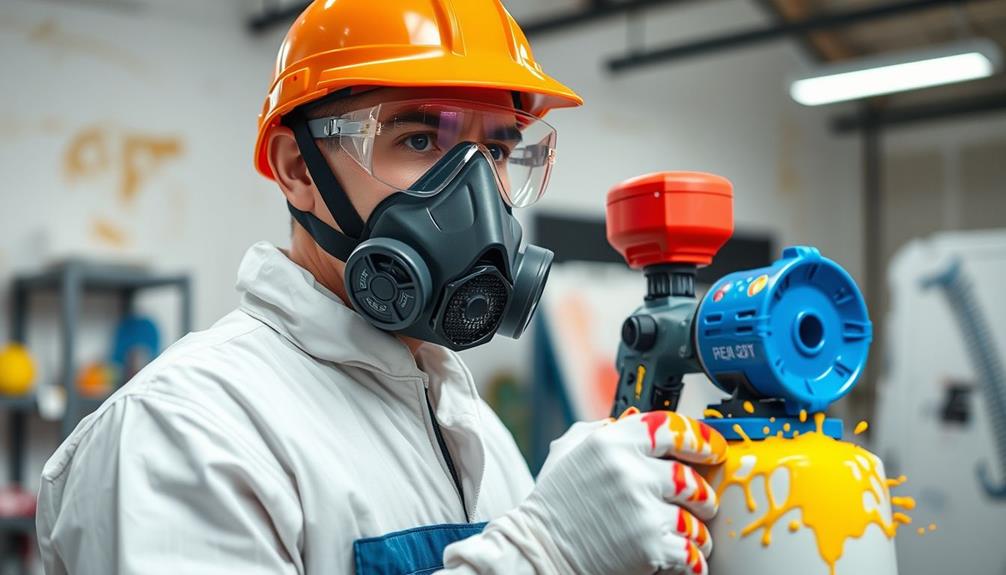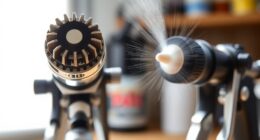To use an airless paint sprayer for whitewashing brick, start by preparing the surface. Clean the bricks thoroughly and repair any mortar joints. Choose a mineral-based paint, diluting it with 3-4 liters of water for consistency. Dampen the brick before spraying to enhance adhesion. Use the sprayer for efficient coverage, keeping an eye on pressure settings. Touch up grout lines with a brush for an even finish. Finally, check for drips and uneven spots after the first coat, making adjustments as needed. Follow these tips, and you'll be well on your way to a stunning result.
Key Takeaways
- Prepare the surface by cleaning and priming to ensure optimal adhesion of the paint.
- Dilute mineral-based paint with 3-4 liters of water for smooth application and coverage.
- Dampen the brick surface before spraying to enhance paint adhesion and achieve an even finish.
- Utilize the airless sprayer for bulk application, paying attention to grout lines with a brush.
- Monitor pressure settings and check for drips during application; touch up as needed after the initial coat dries.
Surface Preparation Steps
Before you plunge into painting with your airless sprayer, it's crucial to prepare the surface properly. Start by confirming all mortar joints are repaired. This step creates a smooth surface and prevents any moisture infiltration that could damage your work later.
For a truly stunning finish, consider incorporating elements of modern farmhouse design into your space. Next, clean the brick surface thoroughly, using a pressure washer to remove dirt and debris. This provides a superior base for paint adhesion.
Once the surface is clean, apply a primer to any caulked joints according to the paint manufacturer's instructions. This enhances the durability and longevity of your finish.
Now it's time to protect your surroundings. Mask windows and any areas you don't want to paint with painter's tape, then cover them with plastic. This protects against paint overspray and helps you achieve clean lines.
Before applying paint, dampen the brick surface. This simple step improves absorption and guarantees an even finish when you use your airless sprayer.
With these preparation steps complete, you're ready to move on to painting your brick with confidence.
Choosing the Right Paint
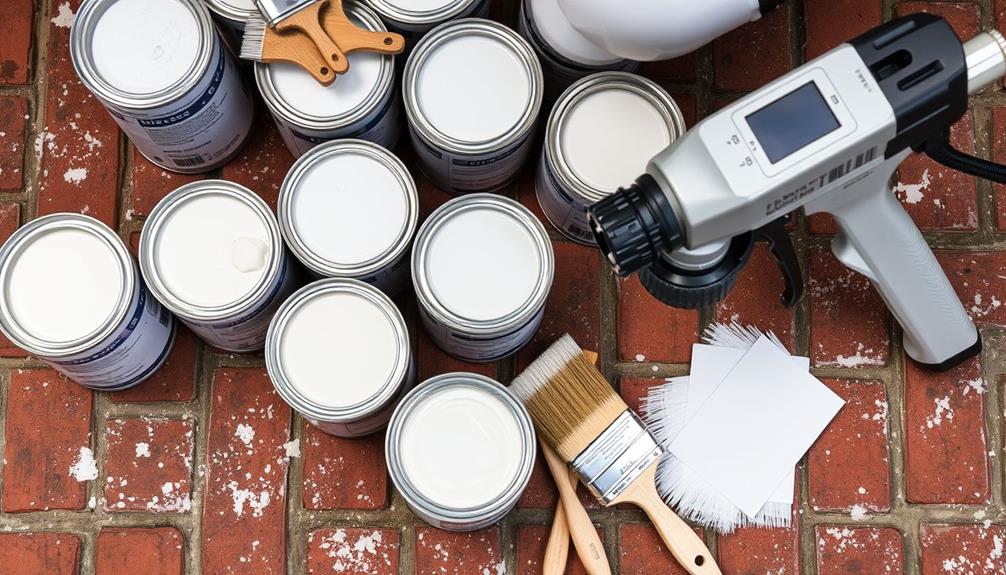
Choosing the right paint for your brick surface is vital to achieving a durable and appealing finish. For whitewashing, you should select a mineral-based paint, like Roma Bio masonry flat, which is breathable and permeable. This prevents moisture issues and promotes longevity.
Here's a quick comparison to help you choose:
| Paint Type | Key Features | Ideal Use |
|---|---|---|
| Mineral-based paint | Breathable, high mineral content | Outdoor applications |
| Non-toxic paint | Environmentally friendly | Safe cleanup |
| Diluted paint | 3-4 liters of water for consistency | best application |
Make certain your paint has a high mineral content for natural mold resistance, especially for outdoor projects. Non-toxic options are also important, as they reduce harmful environmental impacts and allow for safe cleanup. Before applying the paint, consider using a primer on caulked joints to guarantee even coverage and enhance adhesion of the topcoat. By following these guidelines, you'll set yourself up for success in your whitewashing project.
Painting Technique

Achieving a flawless finish when painting with an airless sprayer requires a few key techniques. First, dilute your paint with 3 to 4 liters of water to guarantee ideal spray coverage. A well-prepared paint will flow smoothly through the sprayer, making your job easier.
Airless paint sprayers are designed for efficient application, so take full advantage of their capabilities. Before you start spraying, dampen the brick surface. This step enhances paint adhesion, leading to a more uniform finish.
Use the airless sprayer for the bulk of your application, allowing for faster and more efficient coverage of large areas. However, don't overlook the grout lines; they need special attention. After spraying, use a brush to carefully reach those crevices and guarantee even coverage throughout.
As you apply your initial coat, keep a close eye on the brick texture. If you notice any uneven areas, be ready to apply a heavier second coat in those spots. This will help you achieve a smooth, consistent appearance across the entire surface.
With these techniques, you'll create a beautiful whitewashed look that showcases the character of your brick while guaranteeing durability.
Monitoring Application
While you're painting, it's important to monitor the application process closely to guarantee a consistent finish. This step is vital for achieving the desired look while using your paint sprayer. Here's what to keep an eye on:
- Pressure settings: Regularly check the paint sprayer's pressure to confirm an even application, preventing overspray or under-application. Proper pressure management is similar to how air purifiers improve indoor air quality by maintaining a balanced environment.
- Drips: Look for drips on the foundation and surrounding areas, as they may need touch-ups once the initial coat dries.
- Brick texture: Observe the texture of the brick as you paint, identifying areas that require heavier coverage.
- Paint consistency: Maintain the right flow by diluting your paint mixture with 3 to 4 liters of water, if necessary.
After your first coat, take note of any visible areas that stand out. These observations will help you gauge the effectiveness of your monitoring application and guide any adjustments needed for subsequent coats.
Weather Considerations

Before you start painting, it's crucial to take into account the weather conditions. Always check the weather forecast to make sure you're not caught off guard by rain, which can damage freshly applied paint.
Ideally, you want to paint on dry days with low humidity to provide enough time for proper drying, which typically takes 4 to 8 hours. Additionally, consider the impact of environmental factors on your project; for instance, understanding the key factors in choosing a home cleaning service can help you maintain a clean workspace for your painting.
Avoid painting in direct sunlight; high temperatures can cause the paint to dry too quickly, resulting in uneven coverage and texture. Instead, plan your painting sessions for the morning or late afternoon when it's cooler, reducing the risk of afternoon rain showers.
If inclement weather is predicted, have a strategy ready for covering your work area. Tarps or plastic sheeting can protect your freshly painted surface from unexpected moisture.
Final Touch-Ups and Results
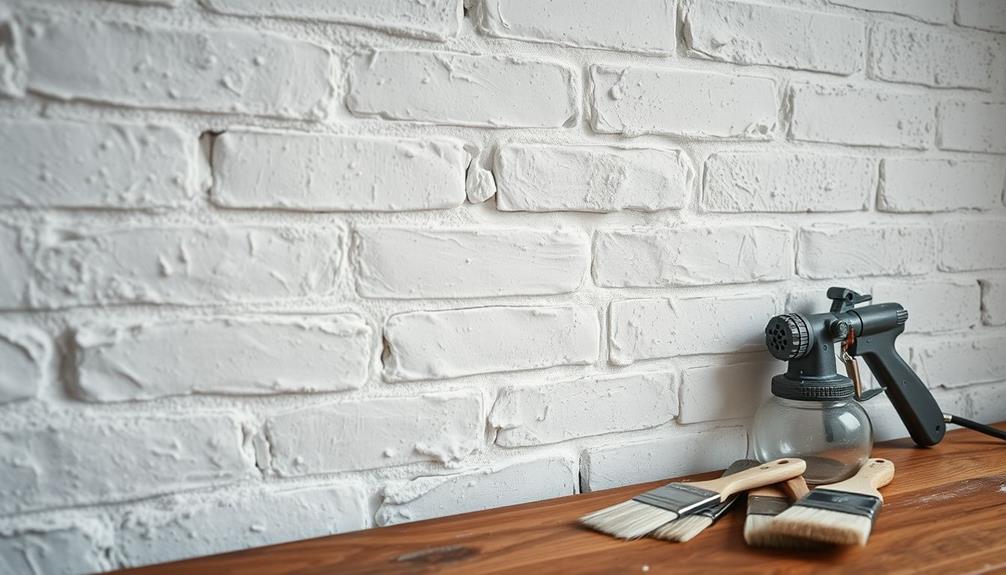
Once the initial coat of paint has dried, it's time to inspect your work for any drips or uneven areas. Pay special attention around the foundation, where imperfections can be more pronounced. If you notice any spots needing a bit more paint, grab a brush for precise touch-ups.
Utilizing the right tools is essential for achieving a professional finish, much like how garage door openers enhance home security with modern technology.
As you go along, keep an eye out for:
- Areas where the brick texture is still visible
- Drips that need smoothing out
- Uneven coverage that detracts from the overall look
- Spots that could benefit from a heavier layer
Before applying any additional coats or final touch-ups, make sure the paint is fully cured, which typically takes about 4 to 8 hours depending on the weather.
Once you're satisfied with the results, don't forget to clean your equipment immediately. This helps keep your airless paint sprayer and brushes in top shape for future projects.
Frequently Asked Questions
Can You Whitewash Brick With a Sprayer?
Yes, you can whitewash brick with a sprayer. It provides even coverage and saves time. Just remember to dilute your paint, dampen the surface, and use a brush for hard-to-reach spots for the best results.
What Kind of Paint Do You Use to Whitewash Brick?
You'd think any paint would do, right? But for whitewashing brick, a mineral-based paint like Roma Bio's your best bet. It breathes, resists mold, and keeps that charming brick look intact while avoiding peeling.
Can You Use a Sprayer to Limewash Brick?
Yes, you can use a sprayer to apply limewash to brick. Just make sure to dilute it properly, dampen the surface, and test a small area first for best results before covering everything.
Can You Spray Masonry Paint With an Airless Sprayer?
Yes, you can spray masonry paint with an airless sprayer. Just dilute it with water for better consistency, dampen the surface beforehand, and choose the right spray tip for even coverage. You'll save time!
Conclusion
Now that you've mastered using an airless paint sprayer for whitewashing brick, you can transform your space with ease. Just imagine the fresh, bright look your bricks will have, breathing new life into your home! By following these steps, you've guaranteed a smooth application and stunning results. So, grab your sprayer and get started—your walls are waiting for that perfect touch of elegance. Isn't it time to let your creativity shine?

